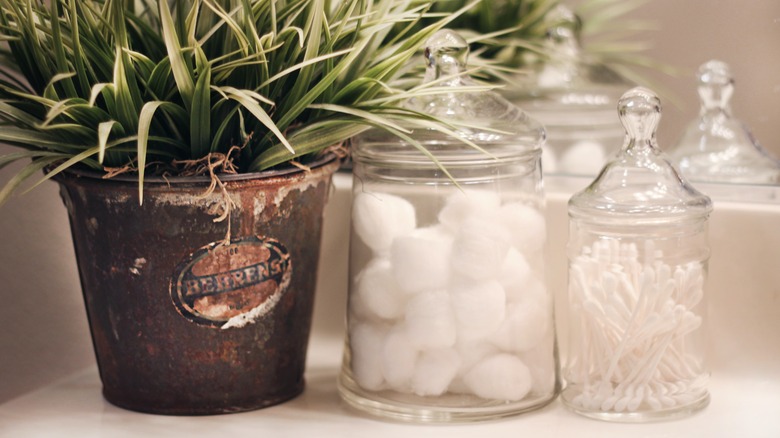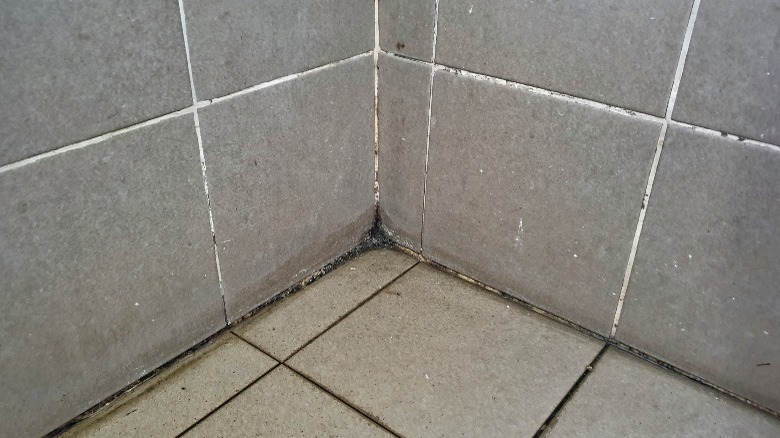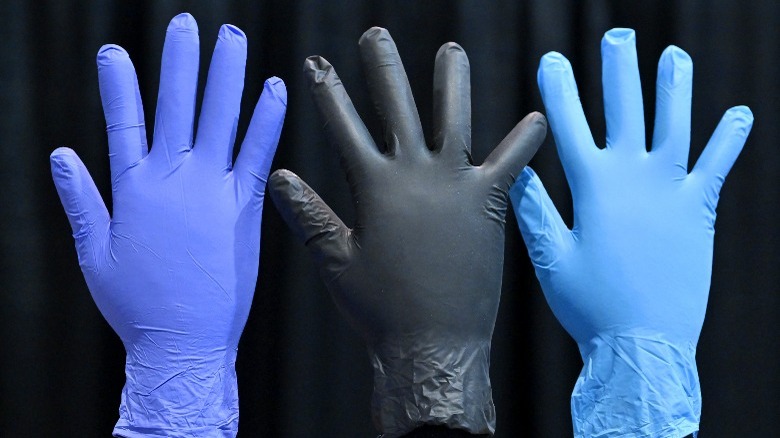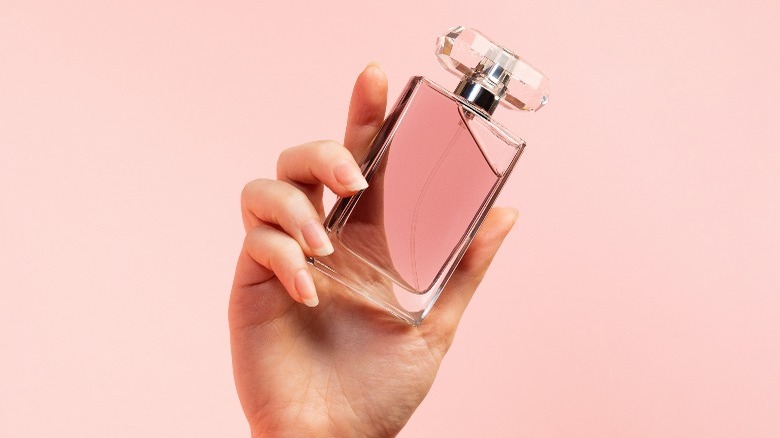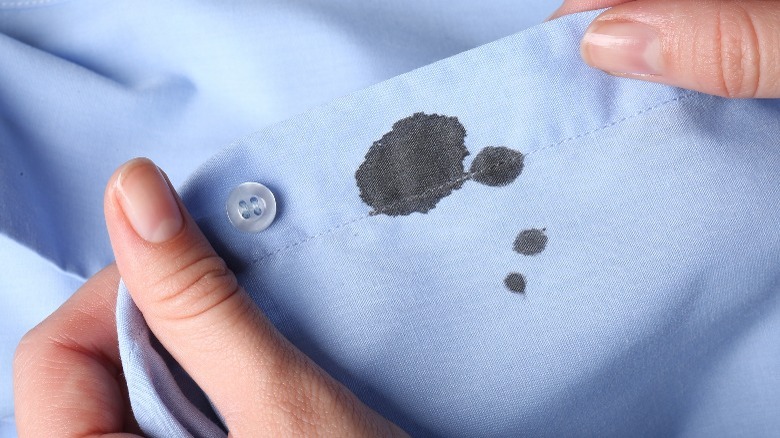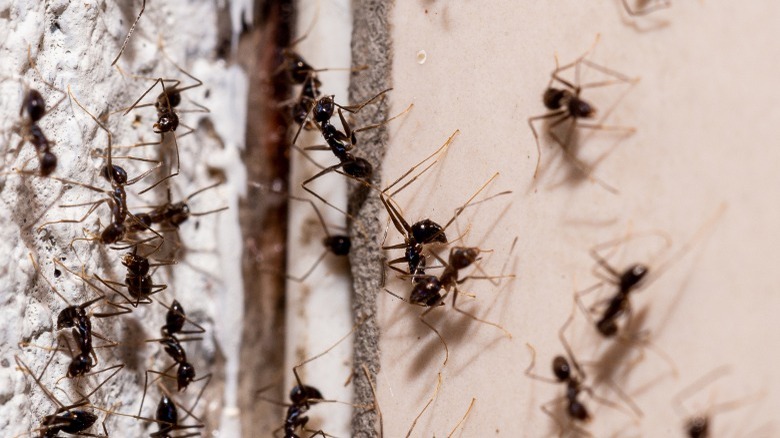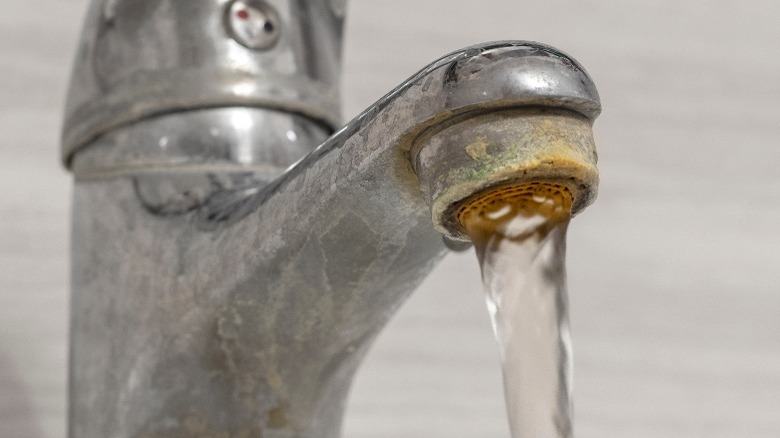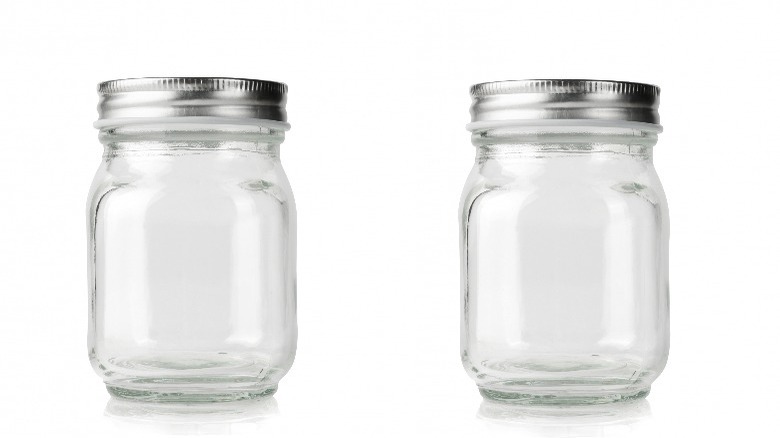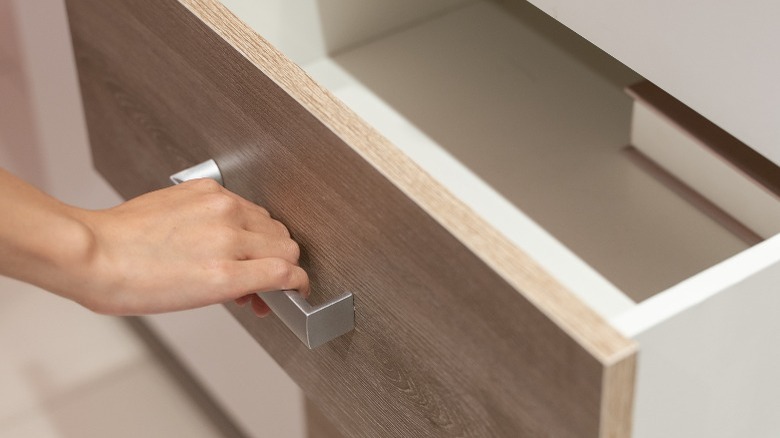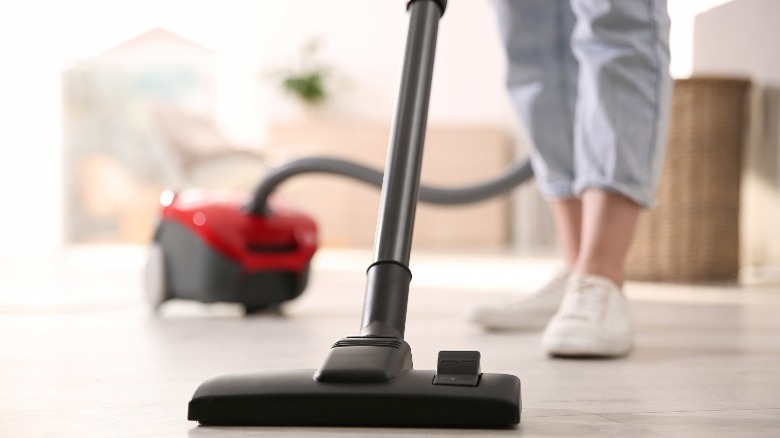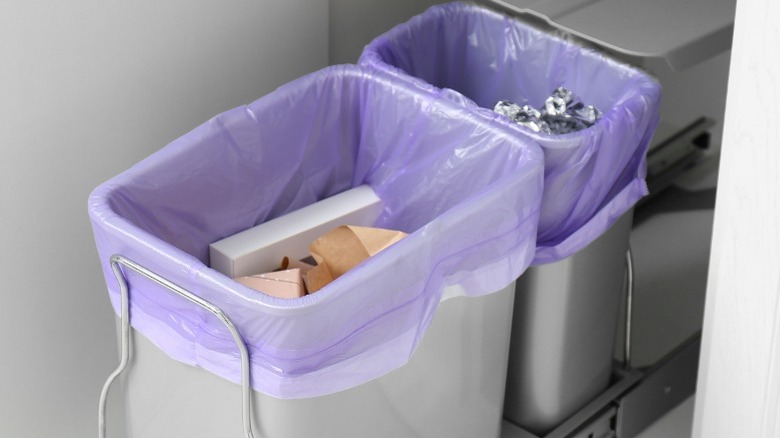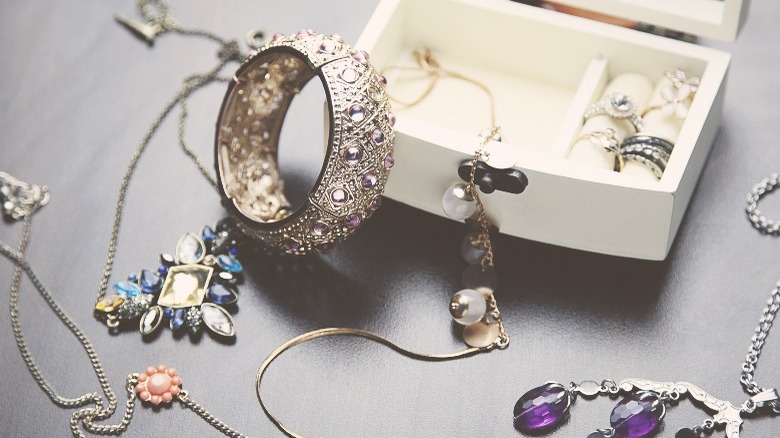Clever Uses For Cotton Balls Around The House
Practically every home has at least one bag of cotton balls. But these small, soft white doo-dads are often underutilized since they are good for much more than removing nail polish and cleaning up cuts. Cotton balls cost little and last forever, and there's no reason why they have to be regulated to a hallway closet or powder room drawer. These little fluffy wonders can be used in some pretty clever ways in and around the house.
Cotton is a natural plant fiber made of cellulose, and rather than being solid, it's composed of tiny fibers resembling miniature straws. These microscopic tubes offer even more empty space, making them incredibly absorbent: That's why they can be used in clever ways throughout homes and gardens. And on top of that, cotton balls aren't abrasive so they won't scratch anything.
The highest quality cotton balls are made from 100% cotton and are incredibly light because most of the volume inside is air. Here are more than a dozen hacks and for most of them, you'll need a few other materials to make them work. But keep in mind that they use cotton balls and not cotton pads. The latter is generally used for applying and removing makeup since they have wider, flat surface areas.
Clean moldy grout
The grout between shower tiles serves as a breeding ground for mold, not just because of the humidity in bathrooms. Grout is made from porous materials like cement, which traps moisture. That's why dealing with mold when it first appears is so important instead of waiting until it penetrates. Moldy grout can be cleaned with store-bought grout removers or DIY cleaners made with products found in the home. Bleach can work, but it can discolor grout and tiles. A gentler cleaner can be made with baking soda and water. This can be poured into a spray bottle and spritzed directly onto the shower walls.
Here's where the cotton balls come in. The spray should sit on the mold for at least 10 minutes to work, but there's a problem. It runs down the tiles and when that happens, it doesn't pool in the vertical grout lines, hard-to-reach areas near the shower door, or in the corners. To make it stay there, grab a handful of cotton balls and open each one up on the side – this is known as breaking the outer layer. Push them into the problem areas, spray on the cleaner, and the cotton will stick to the wall. The mold cleaner will work its way in and when time's up, just pull the cotton balls off and rinse the area.
Line the tips of rubber gloves
Rubber gloves protect hands and nails from hot water and cleaning solutions but they often tear easily. The likelihood of this happening increases for people who have long nails. These gloves aren't as inexpensive as they used to be, and who knows if they are still as durable. There's an easy hack that makes them last longer and protects fingernails.
For this hack, get out five cotton balls and break each one in two. Push a half piece down into each finger of the rubber glove, and use a pencil eraser or other long tool with a soft end to push the cotton to the tip. Don't use a knife or anything else sharp enough to tear a hole. The cotton creates a soft barrier that will preserve that manicure. You might have to experiment with sizes since half a cotton ball might not be enough for someone with small, slender fingers – it may not be enough for someone with large ones. Once the cotton starts feeling uncomfortable or gets dirty, turn the gloves inside out, remove the cotton, and let them dry. Refill the tips with new cotton ball pieces if the gloves are still in decent shape.
Add scent to clothing
Getting dressed in the morning is generally a mundane task, but what if the laundry smelled a whole lot better? Scented detergents and laundry sheets help, but the nice smells quickly fade. Get out the cotton balls and your favorite perfume or aftershave for a longer-lasting, more personalized fragrance. Then, place a handful into a container and spray on the scent.
Don't use too heavy a hand and don't soak the cotton balls in the fragrance. Toss lightly, let them dry, and place one in each clothing drawer. Once the drawers are shut, the perfume will permeate the fabric. Eau de parfum is more concentrated and lasts longer; another option is fragrance oils because they have less alcohol. The perfumed cotton balls won't keep the scent as long in closets since those are more open, but the results will be better if the door stays closed.
Absorb ink stains
Even though the digital age has made using pens somewhat obsolete, they can still leak and cause unsightly ink stains. These marks are notoriously hard to remove but with the right tools the chances for success increase. The golden rule here is to never launder the item until the ink is dissolved – otherwise, it will be there forever.
For the best results, tackle the stain while the ink is still wet. Blot it gently with clean cotton balls before attempting stain removal. Then, soak a cotton ball in isopropyl rubbing alcohol and dab away. This often works but it isn't the only way to break up ink stains. Other options include spraying hairspray onto the cotton ball or putting hand sanitizer or shaving cream on it. A few dabs of non-gel toothpaste or hydrogen peroxide can also work. Always start with a little bit at a time, and never scrub the cotton ball into the fabric.
Disinfect high-touch areas
High-touch areas like cellphones, light switches, and remote controls get covered in germs and should be cleaned frequently. Rubbing alcohol can disinfect them but too much of this liquid will saturate things and possibly cause damage. Disinfecting wipes can work but the prices of these have also gone up. A container of 75 Clorox Wipes costs around $5 and if the lid is left open or not snapped shut all the way, the wipes will dry out. Plus, if you only need to disinfect a small area, there's no reason to use an entire wipe.
Target sells a 200-count bag of cotton balls for $1.99 and 32 ounces of 70 percent isopropyl alcohol for $2.99. Those cotton balls are large enough to be broken in half to reach smaller areas. To disinfect high-touch areas with them, dip them in the alcohol, and squeeze out the excess before wiping down the surfaces. Wearing rubber gloves is optional but recommended, as alcohol can dry out the skin.
Ward off ants
Being greeted by an army of ants can be disconcerting and even disgusting, particularly when the creatures have invaded the inside of a home. While store-bought and DIY ant sprays are effective, cleaning up those tiny carcasses is an unpleasant job. So instead of waiting until these pests make their way indoors, it makes more sense to keep them outside where they belong. This is done by making the home less appealing to them and believe it or not, cinnamon on cotton balls works like a charm.
Ants dislike cinnamon and this makes sense because the smell suffocates and kills them. They also dislike lemon, cayenne pepper, and mint. Choose whichever scent is the least offensive for your home, and either mix some into water or use essential oil. Saturate cotton balls with the liquid and place them in areas where ants could get in. Good spots include window sills, vents, screens, and doorways.
Freshen up the fridge
An open box of baking soda in a refrigerator will absorb odors but it doesn't do much more than that. And since fridge doors are open and closed so often, it would be nice to make the experience more pleasant. This is easily done with cotton balls and a bit of food flavoring. Vanilla extract is the most common choice, but feel try to experiment with almond, lemon, or orange.
This is almost too easy – just drip a few drops of the extract onto one or two cotton balls, place them in a shallow container, and put it on the back of a refrigerator shelf. The scent won't be strong like a vanilla body lotion. Instead, it will be subtle yet strong enough to notice. And to get into the habit, replace this fridge freshener each time a new bottle of the extract is purchased. It's a nice little refrigerator upgrade that's easy to get used to.
Say goodbye to water spots
Homes with hard water are more likely to develop water spots, typically noticeable on chrome and gold-plated fixtures. This residue comes from the excess magnesium and calcium in the water that remains after the water evaporates. So while those faucets aren't technically dirty, the staining mars the appearance.
To remove water spots from chrome fixtures, mix equal parts of white distilled vinegar and water into a container, saturate a cotton ball, and squeeze out the excess. Then, use it to get into all the narrow areas. This should remove the stains unless they are older and more built-up. In that case, pour the mixture into a spray bottle. Spritz this on the mineral deposits and let it sit for 15 minutes before wiping it away with clean cotton balls. The vinegar can be swapped out for rubbing alcohol or ammonia, too. Just remember to wipe down the surfaces with clean water and a microfiber towel when finished.
Repel hungry rabbits
They're so darn cute but rabbits can overtake gardens, eating up edible and non-edible plants. When hungry enough, they will even eat shrubs and bark. There is no such thing as a rabbit-proof plant, so homeowners have to come up with other ways to deter these small invaders.
A fence will keep bunnies out but installing one can be a costly undertaking. Chicken wire also works, but can be a real eyesore around garden beds. An easier solution is to use vinegar-laced cotton balls. Rabbits dislike the smell and it's easy to make DIY repellant hubs using small plastic lidded containers with holes poked into the tops. Thirty-five mm film containers are perfect or just use anything else on hand that can't be gnawed through. Soak cotton balls in vinegar, drop them inside, and secure the lids. These can be placed in strategic spots throughout the garden – replace the balls with new ones every week or so.
Make a DIY fragrance diffuser
Homeowners often avoid using candles because of the fire hazard but this doesn't mean that you can't fragrance your home in other ways. A simple homemade fragrance diffuser does the trick and nothing needs to be burned. To make one, clean out an old salt or pepper shaker or grab a mason jar. Holes will need to be drilled into the top if there are none there. Next, soak several cotton balls in a favorite essential oil and drop them in. There's no need to stick with one oil, though – feel free to combine several. A few suggestions include lemon and clove or honeysuckle and grapefruit. Lavender and eucalyptus are another good combination and can also help people breathe easier and sleep better. Once the cotton balls are soaked and in the container, screw on the lid and enjoy the scent wafting out from the holes.
Protect fingers from drawer slams
Fingers get caught inside drawers that are pushed shut too quickly and it's surprising how painful it can be. Most people have inadvertently slammed a finger in a drawer at one point in their lives and when this happens to a small child, they might be inconsolable.
A few strategically-placed cotton balls can solve this problem forever. The key is to prevent the drawer from closing all the way and when done right, the cotton won't be noticeable from the outside. Fold up and stick small pieces of plumber's, painter's, or duct tape into the nooks where the tops of the sides meet the top corners . Then, push cotton balls onto the sticky surfaces. Test the drawer a few times to ensure that it remains slightly open when closed. The cotton balls will need replacement from time to time, but this hack works and will prevent cuts, blisters, and most importantly, tears.
Add them to vacuum cleaner bags
Another awesome and candle-free way to add a pleasant scent to a home is to place essential oil-scented cotton balls in vacuum cleaner bags. This can be done with new or used bags, but don't do this when one is full of dust and debris. Full bags should be removed and replaced with new ones.
Unplug the vacuum and detach the old vacuum cleaner bag if needed. Place several scented cotton balls inside it, pushing them down through the hole. Attach the bag back in place, and start vacuuming. The subtle fragrance will get dispersed through the air coming through the appliance. It will also get into the rug or carpet fibers, so the scent should last for a while. The fragrance will also come out through the hose, so curtains and fabric furniture can also smell nice. Toss in new ones before each vacuuming and they'll all be thrown out when the bag gets replaced.
Grow seeds in them
Cotton balls can serve as a growing medium for seeds and beans and is an easy way to start seedlings indoors without getting any hands dirty. To germinate seeds in a growing tray, fill in each cube with a damp cotton ball, leaving a bit of room on the tops. Break each one up slightly and sprinkle a few seeds in each. Push the seeds slightly down into the cotton, put this DIY seed incubator in a sunny location, and keep an eye on it. Mist the cotton with water when it dries out. This can also be done in mason jars, but leave about an inch or two on the top.
The two things to remember when using cotton balls to grow seeds are to break up the cotton to loosen the fibers and to never saturate the cotton with water. And once the seeds become seedlings with roots, they can be transferred to larger pots or outside gardens.
Make trashcans smell better
Scented trash bags are made to neutralize garbage odors, but sometimes these products smell way too strong or fake. The manufacturers might use a baking soda derivative to fight odors and Glad bags are made with Febreze-infused material. It has also been reported that Hefty trash bags use odor technology that's integrated on a molecular level.
If all that sounds a bit too high-tech or scary, stick with unscented garbage bags and fight smells with clean-smelling essential oils. These should work to mask unpleasant odors rather than creating new, disagreeable combinations. Avoid sweet and strong ones like bitter oranges and patchouli. Fresher-smelling ones like tea tree, lavender, and lemon are more appropriate.. Simply toss one or two into the bottom of clean trash bags each time you open them up into the cans. Use these in kitchen and bathroom trashcans and recycling cans, too; what could be easier than that?
Use them to light candles and start fires
Cotton balls can come in very handy when a candle wick is too short or a fire needs encouragement to get going. When candles inside containers burn down too low, reaching the wick can be almost impossible without an extra-long match or lighter. When neither is available, break up two cotton balls and roll them out into thinner pieces. Then, twist them together into one piece, light one end, and touch the wick. Voilà! That was easy.
To get a strong fire going, make a Vaseline and cotton ball starter. Vaseline serves as fuel and can create strong, long-lasting fires when a piece of cotton is used. But instead of making a wick from breaking apart the cotton balls, put a blob of Vaseline right on top of one. This firestarter can be placed in the wood and the Vaseline should ignite right away. Vaseline fuel can keep the flames going for a long while.
Protect and clean jewelry
Well-cared-for jewelry lasts longer and cotton balls are one of the best ways to protect it. Since it is non-abrasive, it won't scratch delicate surfaces – it also offers cushioning, which is helpful when the jewelry gets packed up for travel. Delicate necklaces and bracelets can be wrapped around jumbo cotton balls, and earring backs and hooks can be pushed through and secured on smaller ones. Line travel pouches and bags with cotton too, and the pieces won't get damaged when they are bumped around.
Cotton balls can also be used to clean fine jewelry. Dampen them with rubbing alcohol, using enough to corral any stray fibers. Gently dab away at the jewelry and use tweezers if any fibers get stuck. Another option is to soak the pieces in diluted alcohol and rub them with water-dampened cotton balls. Rinse the jewelry with more water, and dry it with microfiber towels.
